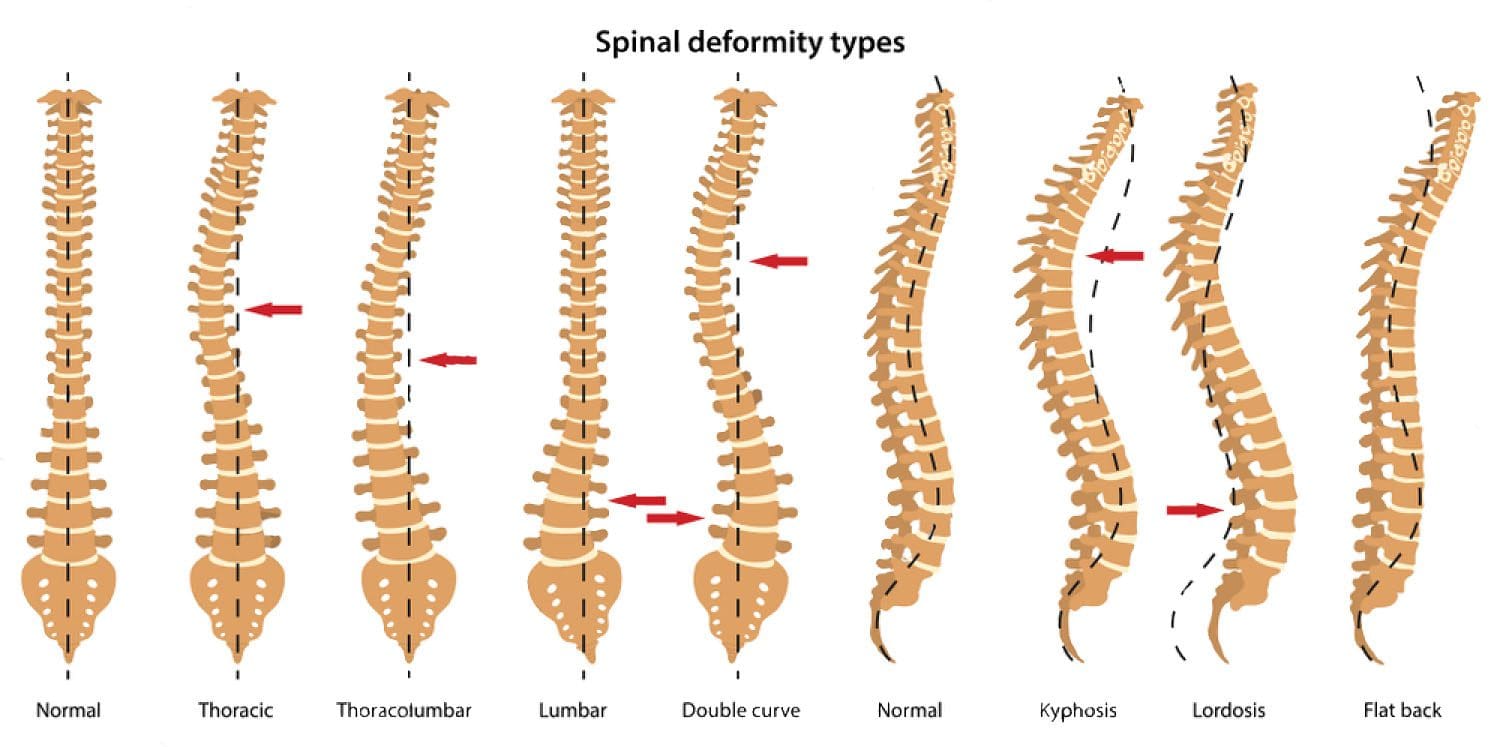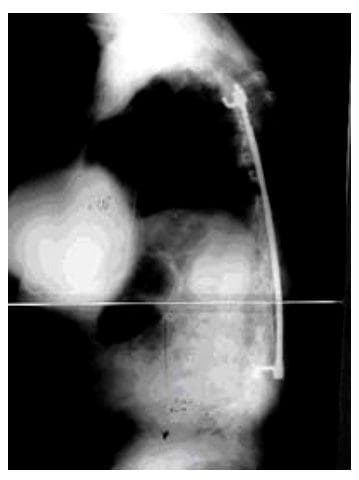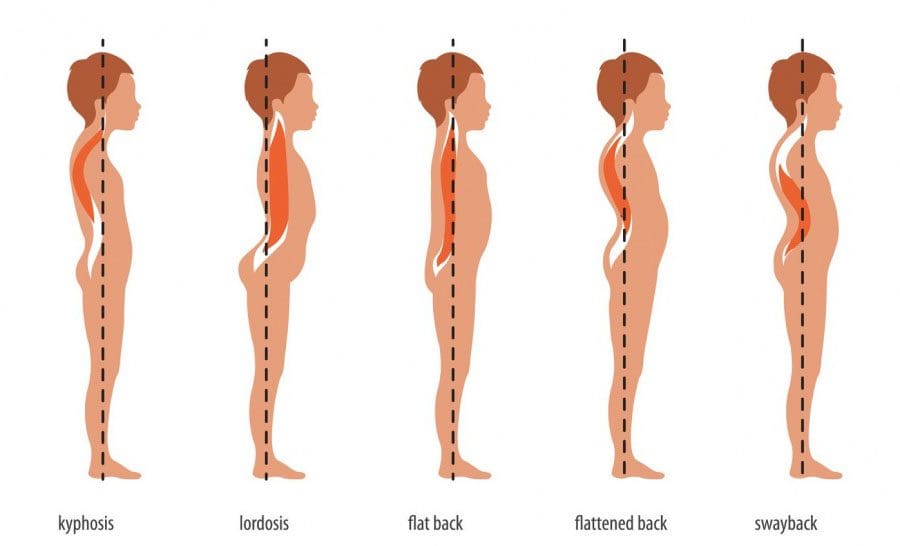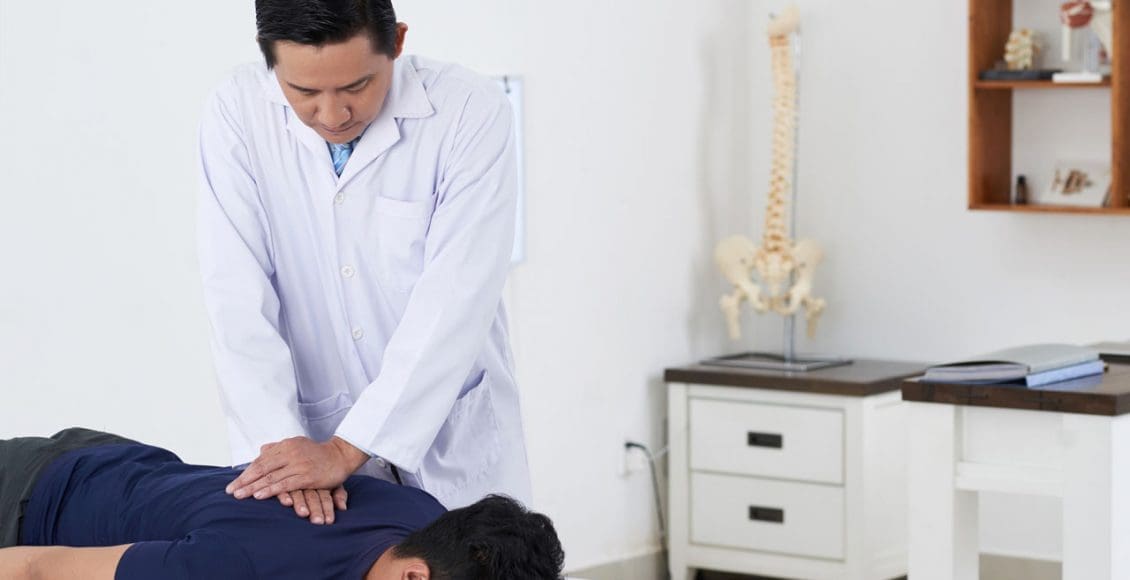Table of Contents
A Normal Spinal Column & Flatback Syndrome
Looking at someone straight on the spine should be straight.
Looking at someone from the lateral or side view the spine shows its varying curvature.
In the neck (cervical spine) and the lower back (lumbar spine) are inward curves known as lordosis.
The thoracic spine, there is an outward curve or kyphosis.

The goal is to have an economical stance and gait that does not require excessive energy.
The curves need to be well-balanced.
The gravity line should fall through:
- The head and cervical spine
- Behind the sacrum
- Through the center of the hips
Like this minimum energy is exerted for standing and walking.
When these curves are not balanced, like what happens with excessive kyphosis in the thoracic spine or loss of normal lordosis in the lumbar spine, the patient may begin to experience symptoms.
Loss of lumbar lordosis or actual kyphosis in the lumbar spine that presents symptoms is named flatback syndrome.
Symptoms
The main symptoms of flatback are:
- Difficulty standing up straight
- Low back pain
- Thigh pain
- Groin pain
Symptoms will worsen as the day progresses with fatigue and increasing difficulty to stand up straight with correct posture.
Individuals will flex or bend their hips and knees to get into an upright position.
This is what causes the exhaustion as the day goes on.
Some patients also have symptoms of:
- Sciatica
- Spinal stenosis
- Leg pain
- Weakness made worse from walking
Some individuals have neck and upper back pain as they strain to get themselves upright.
Trying to live like this can lead to a disabling condition that requires pain medications, and limits the individual’s ability to perform daily activities.
Causes
Flatback syndrome was first described in patients who had been treated with Harrington spinal instrumentation.
This was the earliest type of spine implantation to correct scoliosis.
This instrumentation had a tendency to flatten the normal curve or lordosis in the lumbar spine.
This system was used from the 1960s to the 1980s.
With today’s implant systems and techniques, this problem doesn’t really occur anymore.
But not to knock the system, those treated with Harrington rods did very well for decades.
The spine compensates for the flattening of the lordosis with the normal discs underneath the fused area.
However, when the discs below the fusion would wear out (degenerate), the patients would lose the ability to stand upright and pain would develop.
Other causes include:
Ankylosing Spondylitis
- A chronic inflammatory arthritic disease that causes stiffness and loss of lordosis.
Degenerative Disc Disease
- The normal aging process of the wear and tear/degeneration of the discs, that are the shock absorbers of the spine.
- In the lumbar area, these discs contribute to normal curvature.
- As the discs degenerate, the spine stiffens and the curvature disappears.
- The patient has progressive difficulty in achieving an upright posture.
Post-Laminectomy Syndrome
- After a laminectomy procedure used to decompress the spine nerves, loss of lordosis and instability can develop.
- This type of procedure is associated with failed back surgery syndrome.
Compression Fractures
- Single or multiple vertebrae collapsing can result in loss of lordosis and flatback.
- The vertebrae are the building blocks of the spine.
Diagnosis
The diagnosis begins with a patient’s history.
A doctor will look for the common symptoms like the presentation of difficulty standing upright along with back pain.
If there is a history of prior surgery or a disease making them susceptible to the syndrome.
Full standing x-rays will be ordered.
The lateral side view is specifically the side that will be helpful (see x-ray).

The patient stands, knees straight, the posture can be seen to be stooped forward.
This is depicted by the gravity line/plumb line falling in front of the sacrum.
Finally, MRI’s, CT scans, can be utilized to provide information about the health of the:
- Discs
- Vertebrae
- Degree of openness of the spinal canal to see if there is compression of the spinal nerves or not

Non-surgical Treatment
Patients should try non-surgical treatment first like:
- Chiropractic
- Physical therapy
- Non-steroidal anti-inflammatory medication
Conditioning and endurance exercise programs can provide relief. But, if the structural problem is too great for conservative therapy then surgery is an option.
Reduce Back Pain with *FOOT ORTHOTICS* | El Paso, TX.
Kent S. Greenawalt, President, and CEO of Foot Levelers discusses how custom foot orthotics can help reduce back pain, low back pain, and sciatica.
In a recent research study published by the American Congress of Rehabilitation Medicine (ACRM), researchers demonstrated that Foot Levelers custom foot orthotics help considerably reduce back pain and several of its associated health issues.
The research study also demonstrated that Foot Levelers custom foot orthotics and chiropractic care help tremendously reduce low back pain and sciatica.
Foot Levelers custom foot orthotics and chiropractic care helped improve the patient’s overall health and wellness.
Dr. Jimenez is a chiropractor in El Paso, TX who can help provide these benefits through the utilization of chiropractic care and Foot Levelers custom foot orthotics, among other treatments.
NCBI Resources
Sometimes low back pain comes out of nowhere, but that sudden twinge in the lower back does have a cause. With some cases, there’s a trigger, like picking up a heavy object/furniture from an awkward position. But sometimes it can be a mystery and a challenge to diagnose.
It is important to know the cause of lower back pain to figure out the proper treatment plan. Otherwise, one could receive treatment for the wrong diagnosis and possibly exacerbate the existing injury.
Post Disclaimer
Professional Scope of Practice *
The information herein on "Flatback Syndrome and Back Pain El Paso Texas" is not intended to replace a one-on-one relationship with a qualified health care professional or licensed physician and is not medical advice. We encourage you to make healthcare decisions based on your research and partnership with a qualified healthcare professional.
Blog Information & Scope Discussions
Welcome to El Paso's Chiropractic Scientist wellness blog, where Dr. Alex Jimenez, DC, FNP-C, a board-certified Family Practice Nurse Practitioner (FNP-C) and Chiropractor (DC), presents insights on how our team is dedicated to holistic healing and personalized care. Our practice aligns with evidence-based treatment protocols inspired by integrative medicine principles, similar to those found on dralexjimenez.com, focusing on restoring health naturally for patients of all ages.
Our areas of chiropractic practice include Wellness & Nutrition, Chronic Pain, Personal Injury, Auto Accident Care, Work Injuries, Back Injury, Low Back Pain, Neck Pain, Migraine Headaches, Sports Injuries, Severe Sciatica, Scoliosis, Complex Herniated Discs, Fibromyalgia, Chronic Pain, Complex Injuries, Stress Management, Functional Medicine Treatments, and in-scope care protocols.
Our information scope is limited to chiropractic, musculoskeletal, physical medicine, wellness, contributing etiological viscerosomatic disturbances within clinical presentations, associated somato-visceral reflex clinical dynamics, subluxation complexes, sensitive health issues, and functional medicine articles, topics, and discussions.
We provide and present clinical collaboration with specialists from various disciplines. Each specialist is governed by their professional scope of practice and their jurisdiction of licensure. We use functional health & wellness protocols to treat and support care for the injuries or disorders of the musculoskeletal system.
Our videos, posts, topics, subjects, and insights cover clinical matters, issues, and topics that relate to and directly or indirectly support our clinical scope of practice.*
Our office has reasonably attempted to provide supportive citations and has identified the relevant research studies or studies supporting our posts. We provide copies of supporting research studies available to regulatory boards and the public upon request.
We understand that we cover matters that require an additional explanation of how they may assist in a particular care plan or treatment protocol; therefore, to discuss the subject matter above further, please feel free to ask Dr. Alex Jimenez, DC, APRN, FNP-BC, or contact us at 915-850-0900.
We are here to help you and your family.
Blessings
Dr. Alex Jimenez DC, MSACP, APRN, FNP-BC*, CCST, IFMCP, CFMP, ATN
email: coach@elpasofunctionalmedicine.com
Licensed as a Doctor of Chiropractic (DC) in Texas & New Mexico*
Texas DC License # TX5807
New Mexico DC License # NM-DC2182
Licensed as a Registered Nurse (RN*) in Texas & Multistate
Texas RN License # 1191402
ANCC FNP-BC: Board Certified Nurse Practitioner*
Compact Status: Multi-State License: Authorized to Practice in 40 States*
Graduate with Honors: ICHS: MSN-FNP (Family Nurse Practitioner Program)
Degree Granted. Master's in Family Practice MSN Diploma (Cum Laude)
Dr. Alex Jimenez, DC, APRN, FNP-BC*, CFMP, IFMCP, ATN, CCST
My Digital Business Card





 Again, We Welcome You.
Again, We Welcome You.
Comments are closed.